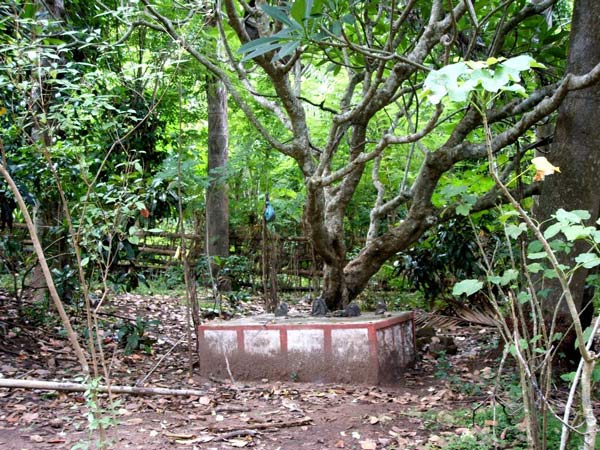
Learn more about the Kaani community >>
United Nations on climate change >>
Many small towns across India also have sacred groves. The kaavus of Kerala are managed by the government, temple trusts, local community, or even privately. In Thrissur, there are as many as 970 such kaavus in the district, of which 220 are in the heavily populated urban taluk of Thrissur. These kaavus are tiny oases rich in floral and faunal biodiversity, many less than an acre in area. They contain rare trees such as the south Indian kanak champa, which is categorized as vulnerable in the IUCN Red List of Threatened Species. They also host a number of birds, bats, butterflies and insects. While there are presiding deities from mainstream Hinduism in these kaavus, the serpent god is popularly worshipped. Thus many of these groves are called sarpakaavu (sarpa meaning snake). A visit here can be a soul-stirring experience. To stand amidst the towering trees draped with creepers, allowing little sunlight even at noon, lit by a lone lamp under the snake shrine, can leave anyone with a sense of awe. The character of these kaavus is, however, changing. Some are being used as garbage dumps by city dwellers, while others are converted to modern temple structures with the trees eventually surrounded by concrete or even cut down.
Source: Cities and Canopies: Trees in Indian Cities by Harini Nagendra & Seema Mundoli, Penguin Random House India, Gurgaon 2019 (p. 109)

Find more titles on related topics
published in India >>
Native and imported, sacred and ordinary, culinary and floral, favourites of various kings and commoners over the centuries, trees are the most visible signs of nature in cities, fundamentally shaping their identities. Trees are storehouses of the complex origins and histories of city growth, coming as they do from different parts of the world, brought in by various local and colonial rulers. From the tree planted by Sarojini Naidu at Dehradun’s clock tower to those planted by Sher Shah Suri and Jahangir on Grand Trunk Road, trees in India have served, above all, as memory keepers. They are our roots: their trunks our pillars, their bark our texture, and their branches our shade. Trees are nature’s own museums.
Drawing on extensive research, Cities and Canopies is a book about both the specific and the general aspects of these gentle life-giving creatures.
Cities and Canopies is not a book that will be forgotten in dusty libraries. And even though it is tucked away under the “Gardening” section on Amazon India and, as Mundoli narrates, bookshops are unsure whether to categorise it as fiction or non-fiction, this is clearly a mainstream book for all readers. It’s a book that will make you smile, it’s what you will gift to other city dwellers, it has riddles you’ll tell with your children and it’s what will trigger conversations with your family about shared memories around a certain tree.
Source: “The stories of our roots”: Book Review and interview with the authors by Aditi Tandon on 19 June 2019
URL: https://india.mongabay.com/2019/06/book-review-the-stories-of-our-roots/
Date visited: 6 March 2020
Tip: to find books released by Indian publishers type the name of author in combination with “tribal” or “Adivasi” or include name of an Indian State, Union Territory or region (e.g. “Bastar”, “Northeast India”, “Nilgiri”).
Technical support
Try the following in case Google Custom Search window or media contents are invisible here: (1) switch from “Reader” to regular viewing; (2) in browser’s Security settings select “Enable JavaScript”; (3) check Google support for browsers and devices | More >>
[Bold typeface added above for emphasis]
One of the finest examples of traditional practices in India based on religious faith which has made a profound contribution to nature conservation has been the maintenance of certain patches of land or forests as ‘sacred groves’. – Dr S.M. Nair | Learn more >>
Research the above issues with the help of Shodhganga: A reservoir of theses from universities all over India, made available under Open Access >>
Find publications by reputed authors (incl. Open Access)
Learn more
Atree.org | Ashoka Trust for Research in Ecology & the Environment (posts)
Biodiversity | Biodiversity hotspot | Hyderabad biodiversity pledge
Climate change | Audio | The Climate Question (BBC Podcast)
eBook | Background guide for education
Ecology and environment | Eco tourism | Tourism | Wildlife tourism
Environmental history and what makes for a civilization – Romila Thapar
Equations blog (Equitable Tourism Options)
Forest Rights Act (FRA) | Hunter-gatherers | Illegal mining | Legal rights over forest land
Information provided by Indian government agencies and other organizations (FAQ)
Nature and wildlife | Crocodile | Elephant | Tiger | Mangrove forest | Trees
PARI’s tales from tiger territory | People’s Archive of Rural India (PARI)
Shola Trust | Nilgiri Biosphere
Water and development – India’s tribal communities
Western Ghats – tribal heritage & ecology
What is the Forest Rights Act about?
Who is a forest dweller under this law, and who gets rights?